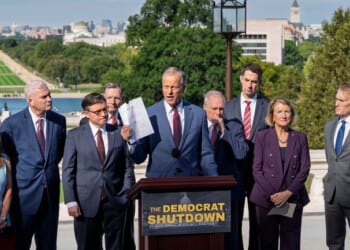Disapproval of the state of the economy is widespread today, despite many indicators improving since the start of the year. The reality is that most Americans’ financial situation deteriorated so much under the Joe Biden administration that there’s a long way to go before this affordability crisis is resolved. Fortunately, there are ways to speed up the process.
Perhaps the best illustration of where most Americans are economically today, and where they’ve been, is to look at real, meaning inflation-adjusted, average weekly earnings. This tells us not only how much the average American makes each week, but what those weekly paychecks can actually buy.
In the first eight months of the Donald Trump administration, real average weekly earnings rose about 1%—a modest improvement, to be sure, but clearly a step in the right direction. People’s incomes rose faster than prices, so they could afford a higher standard of living.
But we need some perspective to understand why people are still so deeply dissatisfied with the economy. In the four years before Trump returned to the White House, real average weekly earnings fell 4% because inflation during the Biden administration far outpaced wage growth.
That means the good progress made thus far this year only reversed about one-quarter of the losses from the prior four years. The average American is still worse off than he or she was before Trump left office.
Housing is another valuable illustration of the affordability crisis plaguing families, particularly those who don’t already own a home. Under the Biden administration, the monthly mortgage payment on a median-priced home more than doubled in less than four years.
This fact alone bifurcated America into a kind of two-tiered society, separating us into those who are lucky enough to buy a home before costs exploded, and those who may be forced to rent for the rest of their lives.In short, the American Dream steadily turned into a nightmare of unaffordability as the price of necessities like housing hit stratospheric levels.
None of this diminishes the strides the Trump administration has made to slow inflation and even lower some prices on consumer staples, like eggs or gasoline. But just because the economy is moving in the right direction doesn’t mean years’ worth of damage has all been undone. It took a while to get into this mess, and it’ll take a while to fix everything.
While this is valuable context for understanding the current political situation, it doesn’t help struggling families put food on the table, gas in the tank, or pay the rent. But the good news is that much more can be done to quickly provide relief and end this affordability crisis.
The Trump administration is already rolling back overregulation, and those efforts should be accelerated. Just as imposing excessive regulation adds costs for American workers, consumers, and businesses, so too will rolling back that overreach provide relief in the form of lower costs.
Regulatory costs are often “hidden,” meaning consumers have no way of identifying what percentage of a product’s or service’s cost is from regulatory burdens. But those costs are nonetheless quite large, estimated at over $2 trillion annually. Repealing just some of this burden would quickly provide billions of dollars in relief to families.
Likewise, the Trump administration could tailor its tariffs more finely to avoid consumer goods or industrial inputs that cannot feasibly be made here, like he did earlier this week for coffee and bananas. Those tariffs are more likely to be passed on to consumers in the form of higher prices, so reducing or eliminating them reduces prices instead.
Lastly, and perhaps most importantly, the Department of Government Efficiency needs to be put on steroids so that it can make drastic cuts to the federal budget. In just a few months, DOGE managed to find billions of dollars in abuse, corruption, fraud, and waste throughout the federal budget—despite being blocked at every turn by bureaucrats and rogue judges.
If the DOGE team were truly given carte blanche, they would undoubtedly save taxpayers billions of dollars more each year. That’s important because these savings would reduce government spending and therefore borrowing. With the government borrowing less money, there’s less upward pressure on interest rates.
Lower interest rates would reduce financing costs for millions of Americans on mortgages, credit cards, student loans, auto loans, and more—providing much-needed relief.
The Biden administration left a full-blown affordability crisis for Trump, and he has been working to douse the flames. But the fire isn’t out yet—only contained. It’ll take a herculean effort to extinguish the inferno, but it can be done.
















